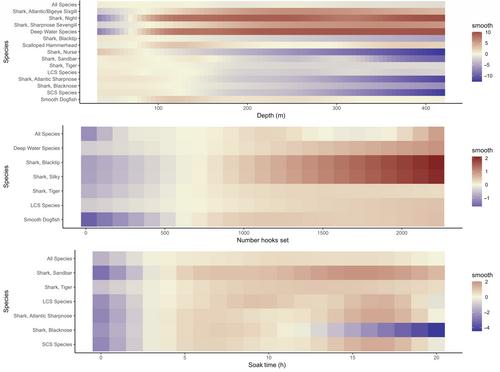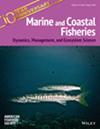Bycatch mitigation for commonly caught shark species in the Gulf of Mexico reef bottom longline fishery
Abstract
Objective
The Gulf of Mexico (GOM) reef bottom longline fishery typically not only targets groupers and snappers but also interacts with 27 species of sharks, which are primarily discarded as bycatch. Slow growth, late maturity, and low fecundity in a landscape of increasing fishing pressure make sharks comparatively more susceptible to overfishing and endangered status than other fishes. The purpose of this study was to determine which gear and/or environmental variables best predict the shark catch per set for commonly caught shark species in the GOM reef bottom longline fishery.
Methods
We considered 12 commonly caught shark species that vary from the abundant Atlantic Sharpnose Shark Rhizoprionodon terraenovae to the critically endangered Scalloped Hammerhead Sphyrna lewini. Catch per set, effort, gear, and environmental data were taken from the National Oceanic and Atmospheric Administration National Marine Fisheries Service observer dataset for the GOM reef bottom longline fishery (2009–2017) and were used to fit generalized additive models. The Bayesian information criterion and 10-fold cross-validation were used to select the best set of variables that predicted catch per set to determine gear configurations, fisher activities, and environmental conditions contributing to higher shark catch per unit effort. We modeled each species individually, all species combined, and species grouped by similar ecology.
Result
Gear and fishing method variables were consistently included in the best predictive models across species and were the only potential basis for a single strategy that could decrease bycatch across all 12 species. Patterns of environmental variables were only consistent across species with similar ecology and habitat.
Conclusion
Sharks as a group should not be lumped together, as the effects of mitigation measures become confounded and directly managing trade-offs between species when minimizing bycatch becomes impossible. Focusing on gear rather than environmental variables is the best apparent option to potentially reduce shark catch per set across commonly caught species while minimizing trade-offs.


 求助内容:
求助内容: 应助结果提醒方式:
应助结果提醒方式:


